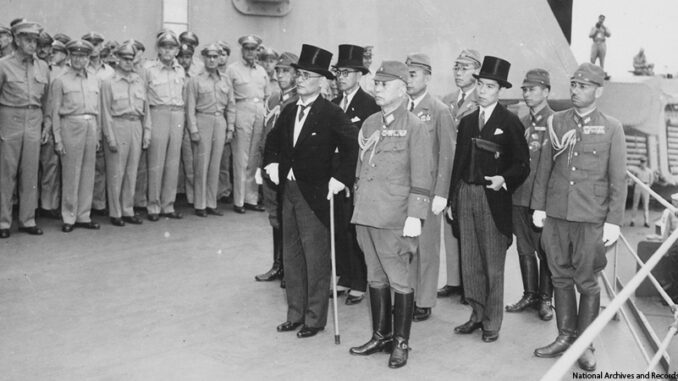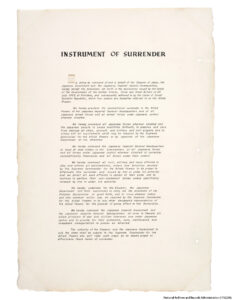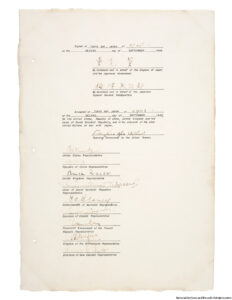
In World War II, the United States and its allies fought against the Axis powers, which at war’s end included Germany and Japan. Did you know that the war concluded on two separate days? Nazi Germany surrendered in May 1945, on what was called V-E (Victory in Europe) Day. It took several more months for Japan to do the same. Imperial Japan surrendered on September 2, 1945. Eighty years later, btw summarizes the events leading to V-J Day, and notes how the event was recently commemorated.
Unconditional Surrender
After Germany surrendered in April, Japan had no more Axis Power allies. The Russian Soviets had been focused on fighting the Germans in Europe but could now turn its military against Japan. In July 1945, Allied leaders from the U.S., Great Britian, and China issued the Potsdam Declaration. The Soviets were withdrawing from the war after disagreeing with its allies at the Potsdam Conference. The document submitted by the U.S., Great Britain, and China laid out the terms for Japan’s unconditional surrender. But Japan never responded, and the war continued.
On August 6, 1945, the United States dropped an atomic bomb on the Japanese city of Hiroshima. Nuclear weapons had never been used in war before. The devastation of the atomic bomb on Hiroshima and its people still did not cause Japan’s surrender. Two days later, the Soviet Union officially declared war on Japan. Still no surrender. On August 9, the United States dropped a second atomic bomb on the city of Nagasaki. That night, Japanese Emperor Hirohito agreed to accept the terms of the Potsdam Declaration. After much negotiation, Japan officially surrendered on September 2, 1945, in a ceremony aboard the USS Missouri in Tokyo Bay.
The Price of Surrender
The world was overjoyed that the war finally had come to an end. But that end came at a tremendous cost. An estimated 140,000 Japanese civilians were killed by the atomic bomb that the U.S. dropped on Hiroshima. About 70 percent of all of the buildings in the city were destroyed. Another 74,000 Japanese were killed when the second bomb fell on Nagasaki. Of the total dead in both cities, an estimated 38,000 were children. Getting help to people was impossible: in Hiroshima, 90 percent of all doctors and nurses were killed or injured, and 42 out of 45 hospitals were rendered ineffective. The devastation caused by nuclear weapons continued long after the bombs were dropped. In the days that followed, radioactive rain poured down on the cities. High rates of cancer, miscarriage, and chronic disease continued for decades. Even today, people are being treated in Japanese hospitals for radiation-induced illnesses.
Remembering the Surrender
Each year, the anniversary of the end of the war is a time to reflect on the high cost of war and to learn from the past in an effort to move toward a peaceful future. As is written on a stone monument at Hiroshima Peace Memorial Park: “Let all the souls here rest in peace for we shall not repeat the evil.”


This year, on the 80th anniversary of the end of the war, the Battleship Missouri Memorial and the Pearl Harbor Aviation Museum worked together to host a series of commemorative events from August 30 to September 2, 2025. The events included new exhibit unveilings, special after-hours events, a commemoration ceremony, film viewings, and concerts.
The celebration also honored several United States World War II veterans, as well as veterans from recent wars. The National World War II Museum also hosted a conversation and reception with several of the war’s surviving veterans. The event was an effort to balance celebration with a somber remembrance of the more than 400,000 American servicemembers killed in the war, and the estimated 65 million who died worldwide. (See this link for an example of a recent event that commemorated the end of the war.)
